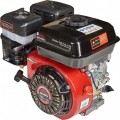Power
The rated power of the engine (the highest power it can deliver in normal operation) in kilowatts. Initially, the power of internal combustion engines (ICE) was usually denoted in horsepower, but now it is also common to record in watts / kilowatts; this, in particular, makes it easier to compare the power of internal combustion engines and electric motors. Some units can be converted to others: 1 hp approximately equal to 0.735 kW.
In general, the more powerful the engine, the more speed and tractive effort it is able to develop. On the other hand, this indicator directly affects the weight, dimensions, and most importantly, the cost of the unit, while the real need for high power is relatively rare. Therefore, it is worth choosing according to this indicator, taking into account the features of the planned application; specific recommendations on choosing an engine for a specific technique and tasks can be found in special sources. We only note that models of the same power can differ in speed and "torque"; see "Shaft speed" for details.
Max. torque
The maximum torque developed by the engine during operation. Note that such an indicator is usually achieved only at certain speeds — this nuance can be specified in the characteristics.
Torque can be simplistically described as the force exerted by a motor on a shaft. The higher this effort, the more “high-torque” the motor is, the better it overcomes resistance and handles with high loads. The torque value is directly related to the power. For example, for 5 hp models. and less torque
up to 10 Nm is considered quite normal, engines of 4 – 7 hp. give out
from 10 to 20 Nm, and values
of 20 Nm or more are found in units with a power of at least 8 hp. At the same time, engines of the same power may differ in actual force. So this indicator characterizes the capabilities of the unit well in comparison with analogues.
It is worth saying that many consider torque to be a more reliable and visual parameter than power: the latter can be indicated in different ways (nominal, maximum, etc.), while torque is a completely unambiguous characteristic.
Shaft position
Standard operating arrangement of the motor shaft. For different types of equipment, a different arrangement will be optimal: for example, lawn mowers are designed for
a vertical shaft, but walk-behind tractors are usually made for
“horizontal” engines. In any case, the choice for this parameter is determined primarily by the requirements of the mechanism for which the engine is purchased.
There are units with a free arrangement that work normally in any position - both horizontal and vertical. This versatility will be especially useful if the engine will be moved from one mechanism to another, and different shaft orientations may be required - or if the unit will be used in different operating positions, and the engine will need to tolerate tilting and turning. The latter is relevant primarily for brush cutters (gasoline trimmers).
Shaft speed
The highest shaft speed provided by the motor. Before buying, you should make sure that this indicator corresponds to the characteristics of the equipment in which you plan to install the engine — too high a speed can damage the working tool, transmission units, etc.
It is also worth considering that a higher rotational speed (for the same engine power and transmission characteristics) means less torque, and vice versa. Therefore, this parameter allows you to compare engines in terms of the speed / thrust ratio (however, only on the condition that they do not have reduction gears — see "Functions").
Shaft length
It is customary to call the shaft length only the length of its outer part protruding beyond the engine housing. The optimal value of this parameter depends on the characteristics of the machine in which the engine is planned to be installed.
Shaft internal thread
The diameter of the internal thread on the motor shaft (more precisely, on its outer end). This information may be necessary for the successful use of the engine with some mechanisms and devices. It can be indicated both as a real value in millimetres (10 mm) and as a marking (5/16-24UNF, M8, etc.).
Compression ratio
The compression ratio provided by the engine.
The compression ratio is the ratio of the total volume of each cylinder (above-piston space at the extreme lower position of the piston) to the volume of the combustion chamber (above-piston space at the extreme upper position of the piston). Simply put, this parameter describes how many times the over-piston space decreases when the piston moves from the bottom to the top.
A higher compression ratio, on the one hand, contributes to an increase in engine efficiency and allows you to achieve more power (compared to analogues of the same volume) and lower fuel consumption (compared to analogues of the same power). On the other hand, with an increase in the compression ratio, the likelihood of detonation (“knocking in the engine”) also increases, which puts forward increased demands on the quality of the fuel.
The lowest compression ratio found in modern engines is about 5.6:1, the highest is about 19:1.
Specific fuel consumption
Specific consumption in this case can be described as the amount of fuel consumed by the engine per hour per 1 kW of generated power. The lower this figure, the higher the efficiency of the engine and the more economical it is. Specific consumption data is especially useful for comparing units with different capacities.

